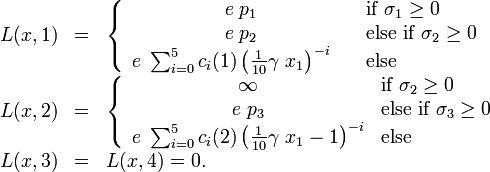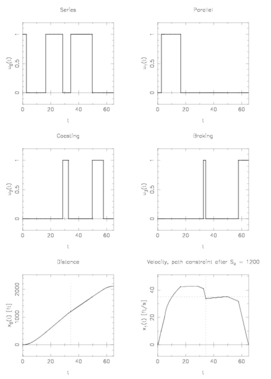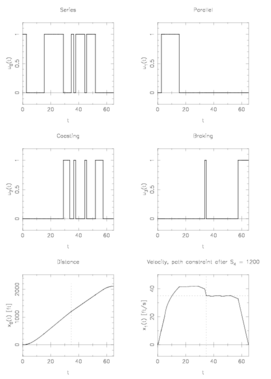Difference between revisions of "Subway ride"
m (Moved C to Muscod) |
FelixMueller (Talk | contribs) (→Mathematical formulation) |
||
| (4 intermediate revisions by the same user not shown) | |||
| Line 15: | Line 15: | ||
<center> | <center> | ||
<math> | <math> | ||
| − | \begin{array}{ | + | \begin{array}{llll} |
| − | \displaystyle \min_{x, w} & | + | \displaystyle \min_{x, w} & \int_{0}^{t_f} & L(x, w) \; \mathrm{d} t \\[1.5ex] |
| − | \mbox{s.t.} & \dot{x}_0 | + | \mbox{s.t.} & \dot{x}_0 & = & x_1, \\ |
| − | & \dot{x}_1 | + | & \dot{x}_1 & = & f_1(x,w), \\ |
& x(0) &=& (0, 0)^T, \\ | & x(0) &=& (0, 0)^T, \\ | ||
& x(t_f) &=& (2112, 0)^T, \\ | & x(t_f) &=& (2112, 0)^T, \\ | ||
| − | & w(t) &\in& \{1, 2, 3, 4\} | + | & w(t) &\in& \{1, 2, 3, 4\}. |
\end{array} | \end{array} | ||
</math> | </math> | ||
Latest revision as of 18:21, 22 February 2016
| Subway ride | |
|---|---|
| State dimension: | 1 |
| Differential states: | 2 |
| Discrete control functions: | 1 |
| Interior point equalities: | 4 |
The subway ride optimal control problem goes back to work of [Bock1982]Address: Taiwan
Author: Bock, H.G.; Longman, R.W.
Booktitle: Proceedings of the American Astronomical Society. Symposium on Engineering Science and Mechanics
Title: Computation of optimal controls on disjoint control sets for minimum energy subway operation
Year: 1982 for the city of New York. In an extension, also velocity limits that lead to path-constrained arcs appear.
The aim is to minimize the energy used for a subway ride from one station to another, taking into account boundary conditions and a restriction on the time.
for the city of New York. In an extension, also velocity limits that lead to path-constrained arcs appear.
The aim is to minimize the energy used for a subway ride from one station to another, taking into account boundary conditions and a restriction on the time.
Contents
[hide]Mathematical formulation
The MIOCP reads as
![\begin{array}{llll}
\displaystyle \min_{x, w} & \int_{0}^{t_f} & L(x, w) \; \mathrm{d} t \\[1.5ex]
\mbox{s.t.} & \dot{x}_0 & = & x_1, \\
& \dot{x}_1 & = & f_1(x,w), \\
& x(0) &=& (0, 0)^T, \\
& x(t_f) &=& (2112, 0)^T, \\
& w(t) &\in& \{1, 2, 3, 4\}.
\end{array}](https://mintoc.de/images/math/d/b/9/db97ec7c21aae9d487d092f3b6709667.png)
The terminal time  denotes the time of arrival of a subway train in the next station. The differential states
denotes the time of arrival of a subway train in the next station. The differential states  and
and  describe position and velocity of the train, respectively. The train can be operated in one of four different modes,
describe position and velocity of the train, respectively. The train can be operated in one of four different modes,  series,
series,  parallel,
parallel,  coasting, or
coasting, or  braking that accelerate or decelerate the train and have different energy consumption.
braking that accelerate or decelerate the train and have different energy consumption.
Acceleration and energy comsumption are velocity-dependent. Hence, we will need switching functions  for given velocities
for given velocities  .
.
The Lagrange term reads as

The right hand side function  reads as
reads as

The braking deceleration  can be varied between
can be varied between  and a given
and a given  . It can be shown that only maximal braking can be optimal, hence we fixed
. It can be shown that only maximal braking can be optimal, hence we fixed  to
to  without loss of generality.
without loss of generality.
Occurring forces are

Details about the derivation of this model and the assumptions made can be found in [Bock1982]Address: Taiwan
Author: Bock, H.G.; Longman, R.W.
Booktitle: Proceedings of the American Astronomical Society. Symposium on Engineering Science and Mechanics
Title: Computation of optimal controls on disjoint control sets for minimum energy subway operation
Year: 1982 or in [Kraemer-Eis1985]Address: Bonn
or in [Kraemer-Eis1985]Address: Bonn
Author: Kr\"amer-Eis, P.
Publisher: Universit\"at Bonn
Series: Bonner Mathematische Schriften
Title: Ein Mehrzielverfahren zur numerischen Berechnung optimaler Feedback--Steuerungen bei beschr\"ankten nichtlinearen Steuerungsproblemen
Volume: 166
Year: 1985 .
.
Parameters
| Symbol | Value | Unit | Symbol | Value | Unit |
|---|---|---|---|---|---|
 |
78000 | lbs |  |
0.979474 | mph |
 |
85200 | lbs |  |
6.73211 | mph |
 |
2112 | ft |  |
14.2658 | mph |
 |
700 | ft |  |
22.0 | mph |
 |
1200 | ft |  |
24.0 | mph |
 |
 |
 |
 |
6017.611205 | lbs |
 |
100 | ft |
 |
12348.34865 | lbs |
 |
10 | - |  |
11124.63729 | lbs |
 |
0.045 | - |  |
4.4 | ft / sec
|
 |
0.367 | - |  |
106.1951102 | - |
 |
32.2 |  |
 |
180.9758408 | - |
 |
1.0 | - |  |
354.136479 | - |
| Parameter | Value | Parameter | Value |
|---|---|---|---|
| b_0(1) | -0.1983670410E02 | c_0(1) | 0.3629738340E02 |
| b_1(1) | 0.1952738055E03 | c_1(1) | -0.2115281047E03 |
| b_2(1) | 0.2061789974E04 | c_2(1) | 0.7488955419E03 |
| b_3(1) | -0.7684409308E03 | c_3(1) | -0.9511076467E03 |
| b_4(1) | 0.2677869201E03 | c_4(1) | 0.5710015123E03 |
| b_5(1) | -0.3159629687E02 | c_5(1) | -0.1221306465E03 |
| b_0(2) | -0.1577169936E03 | c_0(2) | 0.4120568887E02 |
| b_1(2) | 0.3389010339E04 | c_1(2) | 0.3408049202E03 |
| b_2(2) | 0.6202054610E04 | c_1(2) | 0.3408049202E03 |
| b_3(2) | -0.4608734450E04 | c_3(2) | 0.8108316584E02 |
| b_4(2) | 0.2207757061E04 | c_4(2) | -0.5689703073E01 |
| b_5(2) | -0.3673344160E03 | c_5(2) | -0.2191905731E01 |
Reference Solutions
The optimal trajectory for this problem has been calculated by means of an indirect approach in [Bock1982]Address: Taiwan
Author: Bock, H.G.; Longman, R.W.
Booktitle: Proceedings of the American Astronomical Society. Symposium on Engineering Science and Mechanics
Title: Computation of optimal controls on disjoint control sets for minimum energy subway operation
Year: 1982 [Kraemer-Eis1985]Address: Bonn
[Kraemer-Eis1985]Address: Bonn
Author: Kr\"amer-Eis, P.
Publisher: Universit\"at Bonn
Series: Bonner Mathematische Schriften
Title: Ein Mehrzielverfahren zur numerischen Berechnung optimaler Feedback--Steuerungen bei beschr\"ankten nichtlinearen Steuerungsproblemen
Volume: 166
Year: 1985 , and based on the direct multiple shooting method in [Sager2009]Author: Sager, S.; Reinelt, G.; Bock, H.G.
, and based on the direct multiple shooting method in [Sager2009]Author: Sager, S.; Reinelt, G.; Bock, H.G.
Journal: Mathematical Programming
Number: 1
Pages: 109--149
Title: Direct Methods With Maximal Lower Bound for Mixed-Integer Optimal Control Problems
Url: http://mathopt.de/PUBLICATIONS/Sager2009.pdf
Volume: 118
Year: 2009 .
.
Time  |
 |
 |
 [ft] [ft] |
 [mph] [mph] |
 [ftps] [ftps] |
Energy |
|---|---|---|---|---|---|---|
 |
1 |  |
0.0 | 0.0 | 0.0 | 0.0 |
 |
1 |  |
0.453711 | 0.979474 | 1.43656 | 0.0186331 |
 |
1 |  |
10.6776 | 6.73211 | 9.87375 | 0.109518 |
 |
2 |  |
24.4836 | 8.65723 | 12.6973 | 0.147387 |
 |
2 |  |
57.3729 | 14.2658 | 20.9232 | 0.339851 |
 |
1 |  |
277.711 | 25.6452 | 37.6129 | 0.93519 |
 |
3 |  |
1556.5 | 26.8579 | 39.3915 | 1.14569 |
 |
3 |  |
1600 | 26.5306 | 38.9115 | 1.14569 |
 |
4 |  |
1976.78 | 23.5201 | 34.4961 | 1.14569 |
 |
- |  |
2112 | 0.0 | 0.0 | 1.14569 |
Variants
The given parameters have to be modified to match different parts of the track, subway train types, or amount of passengers. A minimization of travel time might also be considered.
The problem becomes more challenging, when additional point or path constraints are considered.
Point constraint
We consider the point constraint

for a given distance  and velocity
and velocity  . Note that the state
. Note that the state  is strictly monotonically increasing with time, as
is strictly monotonically increasing with time, as  for all
for all  .
.
The optimal order of gears for  and
and  with the additional interior point constraints (\ref{FASOPOINTCON}) is
with the additional interior point constraints (\ref{FASOPOINTCON}) is
 . The stage lengths between switches are 2.86362, 10.722, 15.3108, 5.81821, 1.18383, 2.72451, 12.917, 5.47402, and 7.98594
with
. The stage lengths between switches are 2.86362, 10.722, 15.3108, 5.81821, 1.18383, 2.72451, 12.917, 5.47402, and 7.98594
with  . For different parameters
. For different parameters  and
and  we obtain the gear choice 1, 2, 1, 3, 2, 1, 3, 4 and stage lengths
2.98084, 6.28428, 11.0714, 4.77575, 6.0483, 18.6081, 6.4893, and 8.74202
with
we obtain the gear choice 1, 2, 1, 3, 2, 1, 3, 4 and stage lengths
2.98084, 6.28428, 11.0714, 4.77575, 6.0483, 18.6081, 6.4893, and 8.74202
with  .
.
Path constraint
A more practical restriction are path constraints on subsets of the track. We will consider a problem with additional path constraints

The additional path constraint changes the qualitative behavior of the relaxed solution. While all solutions considered this far were bang-bang and the main work consisted in finding the switching points, we now have a path-constrained arc. The optimal solutions for refined grids yield a series of monotonically decreasing objective function values, where the limit is the best value that can be approximated by an integer feasible solution. In our case we obtain 1.33108, 1.31070, 1.31058, 1.31058, ...
The plot shows two possible integer realizations, with a trade-off between energy consumption and number of switches. Note that the solutions approximate the optimal driving behavior (a convex combination of two operation modes) by switching between the two and causing a touching of the velocity constraint from below as many times as we switch.
- Reference solution plots
The differential state velocity of a subway train over time. The dotted vertical line indicates the beginning of the path constraint, the horizontal line the maximum velocity. Left: one switch leading to one touch point. Right: optimal solution for three switches. The energy-optimal solution needs to stay as close as possible to the maximum velocity on this time interval to avoid even higher energy-intensive accelerations in the start-up phase to match the terminal time constraint  to reach the next station.
to reach the next station.
Source Code
Model descriptions are available in
References
| [Bock1982] | Bock, H.G.; Longman, R.W. (1982): Computation of optimal controls on disjoint control sets for minimum energy subway operation. %publisher%, Proceedings of the American Astronomical Society. Symposium on Engineering Science and Mechanics |  |
| [Kraemer-Eis1985] | Kr\"amer-Eis, P. (1985): Ein Mehrzielverfahren zur numerischen Berechnung optimaler Feedback--Steuerungen bei beschr\"ankten nichtlinearen Steuerungsproblemen. (%edition%). Universit\"at Bonn, Bonn, %pages% |  |
| [Sager2009] | Sager, S.; Reinelt, G.; Bock, H.G. (2009): Direct Methods With Maximal Lower Bound for Mixed-Integer Optimal Control Problems. Mathematical Programming, 118, 109--149 |  |

